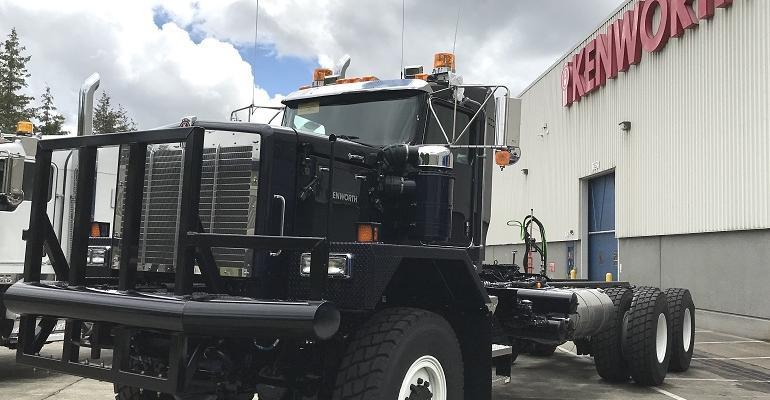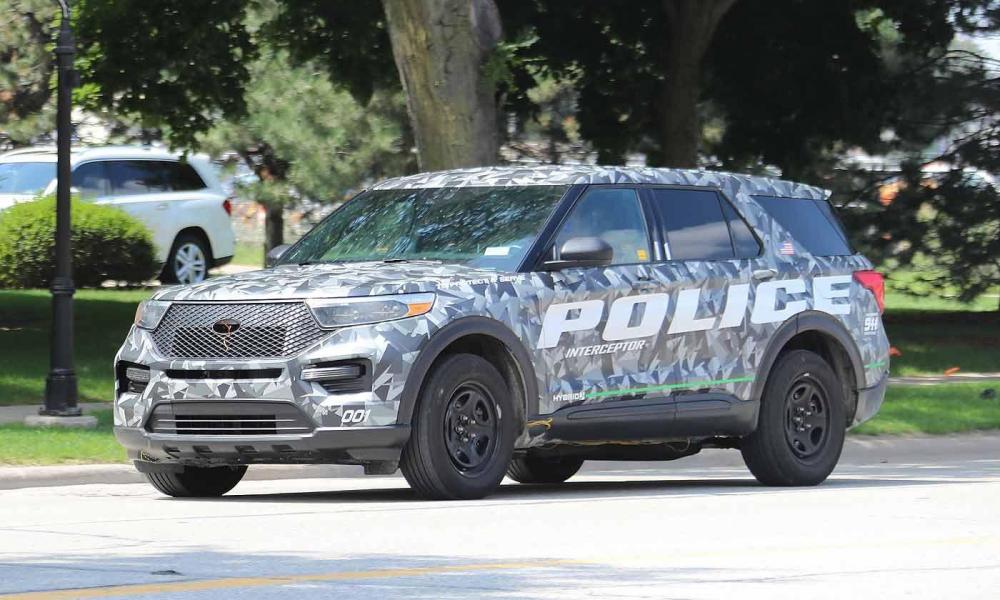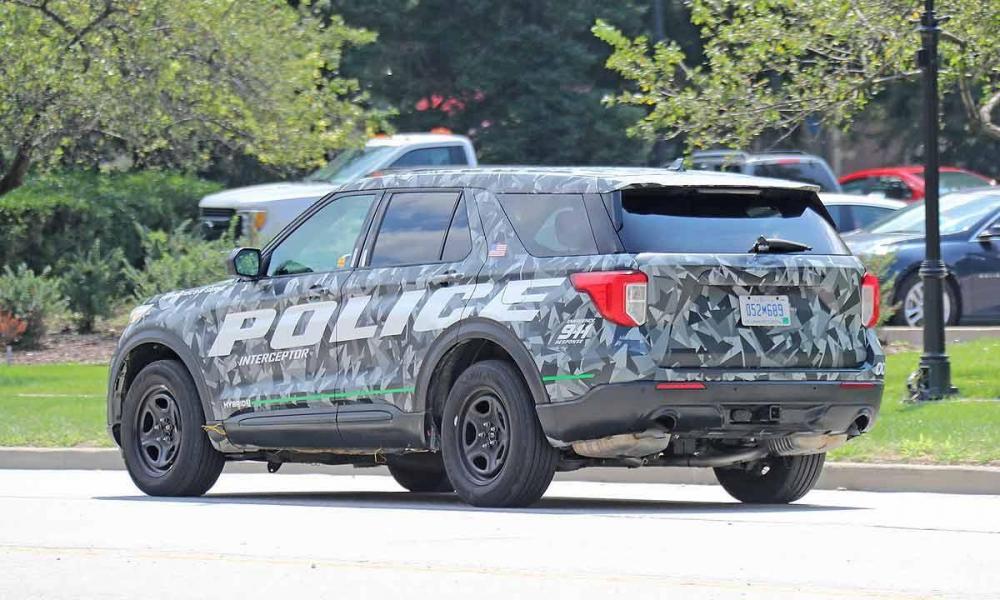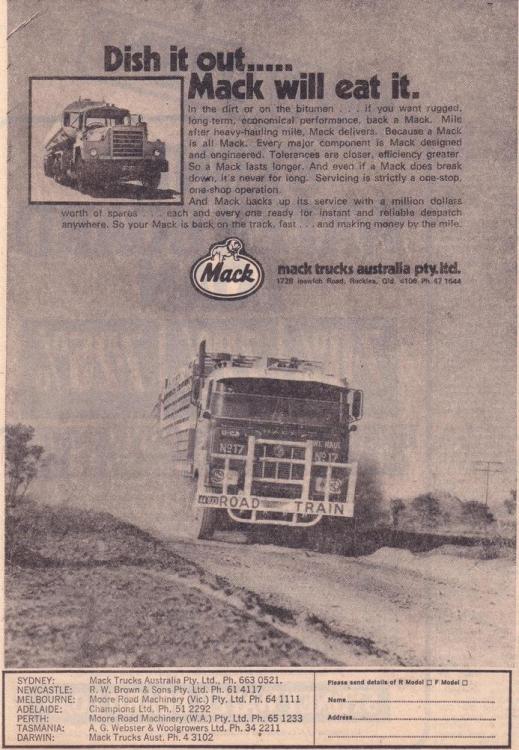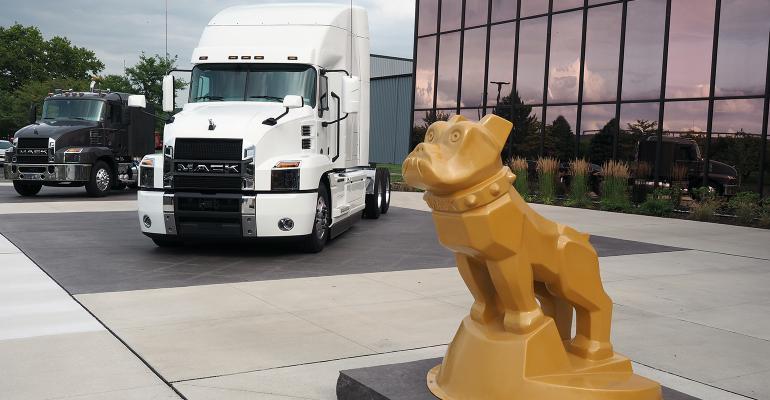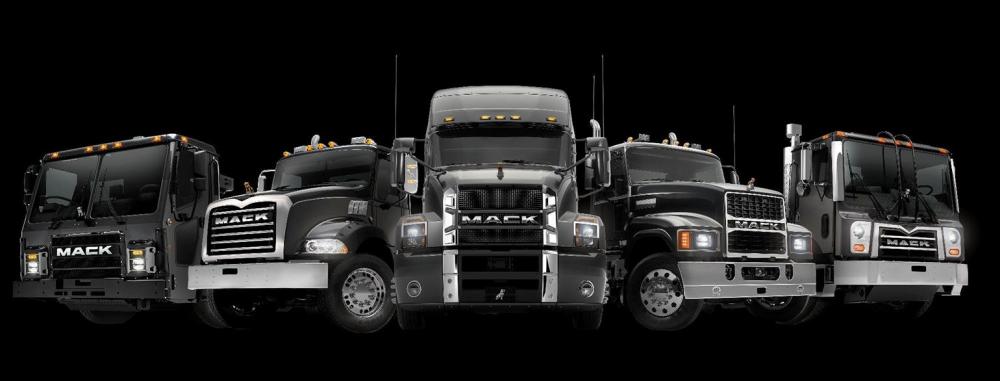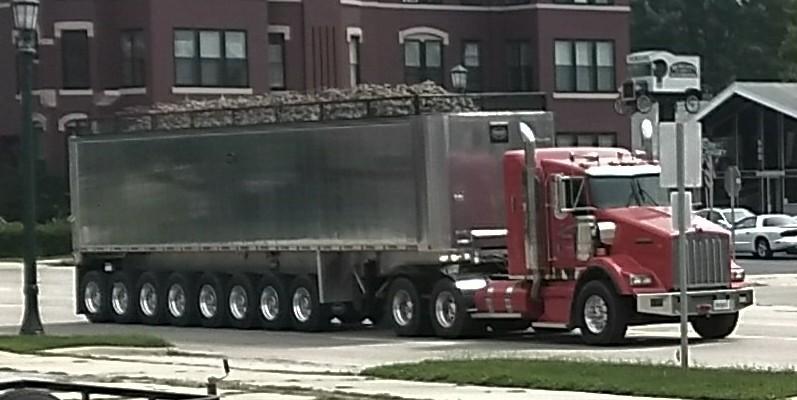
kscarbel2
Moderator-
Posts
18,886 -
Joined
-
Days Won
114
Content Type
Profiles
Forums
Gallery
Events
Blogs
BMT Wiki
Collections
Store
Everything posted by kscarbel2
-
Mack's New Top Dog Addresses Company Successes and Challenges John G. Smith, Today’s Trucking / August 22, 2018 Though just recently named president of Mack Trucks, Martin Weissburg is no stranger to the trucking industry. “My whole career has been with trucks, trailers, construction equipment,” he said during a broad-ranging discussion with media at the company’s customer center in Allentown, Pennsylvania. He was named president June 1, succeeding Dennis Slagle, who had been in the role since 2008. Before that, Weissburg held senior and executive positions with the Volvo Group, including president of Volvo Construction Equipment in Europe, president and CEO of Volvo Financial Services, and president of Volvo Financial Services America. Having grown up in Maryland near Mack's headquarters in Pennsylvania, Weissburg described his new position with Mack is "the dream job." The company has seen improved sales as a result of the economic boom, as well as the success of the Mack Anthem, which helped the company gain share in the highway segment. Sales for models with 70-inch sleepers have doubled in comparison to last year. "It couldn't have come at a better time," Weissburg said. "The highway segment is just smoking." Production at the company’s Lehigh Valley Operations facility is now at an all-time high, with 2,400 employees, including 400 personnel added since last year last year. The booming economy presents its own challenges, though, as it has with other manufacturers. “Generally speaking, we’re in an environment where costs are up,” he said, referring to the prices of raw materials like steel and aluminum as an example. Not all of those increases are related to Trump administration tariffs. But the tariffs have created an environment that has seemingly given every supplier permission to raise prices. Labor demands are adding price pressures of their own, with industrial jobs at a 17-year high and more open jobs than there are applicants. “Logistics costs are up for everyone,” he added. Even those who make the trucks are paying more for those services. “We have our share of challenges in the supply chain as well,” Weissburg said, referring to constraints that keep build rates from growing at a faster rate. “There’s no single, major point of pain. Just right when you fix one, there’s another one.” To push Mack forward, the company continues to make new investments, primarily geared toward maintenance. Certified Uptime Centers and over-the-air engine updates are meant to cut down maintenance time and address preventative maintenance issues. Mack is also looking toward electrification, with plans to demonstrate an electric Mack LR refuse truck for the New York City Department of Sanitation in 2019. "This is coming," Weissburg said. "We can envision a fully electric site in the future." .
-
Trailer-Body Builders / August 22, 2018 Kenworth Truck Company’s assembly plant in Renton, Washington recently celebrated its 25th anniversary. Kenworth employees and their family members marked the anniversary in conjunction with Kenworth Family Day held at the plant. The event included antique Kenworth trucks, an employee classic car show, plant tours, a City of Renton fire truck, and much more, the company said. “More than 1,300 people from across PACCAR attended Kenworth Family Day, which was a great way to celebrate our employees and the plant’s 25th anniversary,” said Bart Hoemann, Kenworth’s Renton plant manager. “Kenworth Renton employees had an opportunity to showcase their workplace to their families, have some fun, and enjoy all the activities and food. Employees are critical to the plant’s success with the quality, innovation, technology and care they build into every Kenworth truck produced here.” Kenworth opened the 300,000 square-foot plant in 1993 on a 40-acre site in Renton. The plant’s first truck, a Kenworth T600B – a later version of Kenworth’s first aerodynamic truck – was presented to Stevens Transport. In 2000, Fortune magazine recognized the Renton plant as one of America’s Elite Factories, and the plant received Assembly Magazine’s inaugural Assembly Plant of the Year Award in 2004. A year later, Kenworth Renton had the honor of producing the 700,000th Kenworth truck in company history. In the past 25 years, the Renton plant has produced more than 144,000 Kenworth trucks. The plant currently produces the T680, T880, T800, W900, C500, K500 and 963 models, along with medium duty Kenworth T370s and T440s. Nearly 20 percent of the plant’s current employees have been working for Kenworth since the plant opened. “Kenworth’s long-term success in the trucking industry can be traced back to a philosophy established early in the company’s history,” Hoemann said. “Build the right Kenworth truck for each customer’s application, and build that truck to last. “That philosophy continues today at the Kenworth Renton plant.” .
-
Ford's 2020 Explorer breaks cover as pursuit vehicle Automotive News / August 22, 2018 The best look yet at the redesigned 2020 Ford Explorer crossover, one of the top-selling U.S. light trucks, emerged Wednesday when a photographer captured images of the next Ford Explorer Police Interceptor Hybrid nearly undisguised on the streets of Dearborn, Mich., home to the company's chief engineering center. Ford released a teaser image and details of the 2020 Police Interceptor in June with lights glaring in the dark, but little detail could be made of the image. The redesigned 2020 Explorer will share the same rear-wheel-drive platform, with optional all-wheel drive, as the all-new 2019 Lincoln Aviator. The Aviator was introduced at the New York auto show in April but Ford hasn't indicated when the next-generation Explorer will be unveiled. Ford declined to comment on the latest Explorer Police Interceptor Hybrid photos but said late Wednesday it will "have more to say on the all-new Explorer for retail customers later." U.S. sales of the Explorer have dropped 3.6 percent this year to 151,488 but it remains the top-selling large crossover, though the segment has grown 12 percent behind higher demand for the redesigned Chevrolet Traverse and Buick Enclave, the Toyota Highlander and Mazda CX-9, and the all-new Volkswagen Atlas and Subaru Ascent. Based on the latest photographs, the Explorer Interceptor features a more rakish profile, a plastic mesh-esque grille, sharper headlights and sculpted LED fog lights. From the side, it appears the Explorer receives a tighter greenhouse, sharper C-pillar and a revised character line that now flows through the door handles. The D-pillar has been reworked with a more aggressive angle. The tailgate, bumper and taillights also appear more angular. The 2020 Explorer Interceptor will feature additional cargo capacity while passenger volume will remain flat, according to Ford's website. .
-
Delphi Technologies PLC (DLPH), the popular fuel injection supplier for Volvo and Mack-badged Volvo engines, set a 52-week low today of $37.44 on abnormally high volume. Their 52-week high was 104.09. Interestingly, today was an up day for the market...........the number of companies hitting 52-week lows on the NYSE and Nasdaq was quite low. On another note, Ford (F) has bounced somewhat off the bottom, closing the day at $9.69.
-
Mack Trucks - Sales Marketing
kscarbel2 replied to kscarbel2's topic in Modern Mack Truck General Discussion
-
Aaron Marsh, Fleet Owner / August 21, 2018 ALLENTOWN, PA. Has the North American Class 8 truck market—which hit a record high for orders last month—peaked? It's possible, speculates Martin Weissburg, the new president of Mack Trucks, but for now, every indication is that demand will stay very high for at least a few quarters. And 2019 is looking likely to be a strong year for the market as well, the OEM predicts. Weissburg took the reins at Mack on June 1, which he calls "the dream job of a career based in the heavy equipment industry," and says he and the company are keeping in close tabs with suppliers to be sure there's enough parts to keep the assembly lines rolling. The company isn't experiencing any shutdowns, but that requires constant vigilance. "We have our share of challenges in a stretched supply chain. Mack Trucks is not immune to that," he told reporters in a meeting yesterday at the Mack Customer Center. "Just when you fix one [potential supply problem], there's another pain point that pops up." On that note, he said Mack's truck production at its Lehigh Valley Operations in Macungie, PA, which boasts some 2,400 employees, "is at an all-time high" and the facility is putting out as many trucks as it can. Instead of speeding things up any further to get more trucks out the door, though, "if anything, I'd rather slow the line down to ensure quality," Weissburg noted. "We never let a truck out that's not ready." He added that with competition extremely high among OEMs, any compromise in quality and decrease in truck reliability would only come back to haunt you. "We view any truck down as a crisis," Weissburg said. To help with that, since any truck lineup will have breakdowns, Mack's Uptime Center in Greensboro, NC takes calls and assists 24/7 if a Mack truck has a problem. That relatively new facility and service are part of what Mack sees as essential to new truck sales going forward, according to Jonathan Randall, senior vice president of North American sales at the company. He said Mack has been testing out over-the-air updates with "several hundred" trucks from across Mack's lineup. Rather than having to bring a truck in to a dealership, OTA service can handle a variety of things like software fixes and updates and can be scheduled when the driver has some available time. As it's currently set up, the truck's ignition is switched off and back to "on" and the update/ service can be performed. Mack began working with OTA service after studying truck repairs. The OEM found that the average time in the shop for trucks was four days, but the average repair took only four hours. So there's an opportunity to save fleets and drivers considerable expense by avoiding that shop visit. "It's all about limiting breakdowns, but when downtime or dwell time occurs, it's about making it as little as possible," Randall said. With increasing computerization of heavy trucks, OTA service and updates are one approach to solving the problem. The follow-up after the sale has also become a key point in this market for OEMs to differentiate themselves. "Buying a Mack truck is not just a point-in-time purchase," Weissburg said. "We're a relationship company, not just a vendor of trucks." Mack has invested some $3 million in its Allentown Customer Center in the last few years and another $80 million in the Lehigh Valley Operations truck assembly plant. That's not a static thing: "There's always the need to spend more in a factory," Weissburg noted. Mack's dealer network has also been making sizeable investments in shops, personnel, parts, and facilities, according to the company. All those elements of the supporting network have come to bear in this year of very high market demand. Weissburg also contended Mack has been well-positioned with its product portfolio, including a fresh on-highway offering with the launch of the Anthem tractor last fall. It made for good timing, although he pointed out the company might've wished the launch came about six months earlier. He said demand for the Anthem "has exceeded all our expectations." While he didn't get into specific figures, he and Randall said Mack has had twice as many orders for on-highway trucks so far this year than the number of those trucks the company delivered in all of 2017. On-highway was a weaker point for Mack prior to this, and it's an area the OEM is looking to grow its market share. Randall noted that on-highway trucks is where all the frenzy has been this year in terms of truck-buying—so much so that other areas like construction, where demand has been more level, have shrunk as part of the overall sales equation. Still, another big part of Mack's sales continues to be the Granite, which has also seen recent updates and can be spec'd as a dump truck, mixer, tractor, and other configurations. Also in terms of future preparation, Mack announced this spring it would begin testing a fully electric LR refuse truck with the New York City Dept. of Sanitation. "The first prototypes are in the works, and we're going to bring that out in late '19, early '20 for the first demo units," Weissburg said. "This is coming," he added. "The conventional wisdom is that start-stop operations like refuse are going to be an absolute winner for electrifying trucks." Mack hasn't released its predictions for the Class 8 market next year, but Weissburg said the company expects it will be another strong one. There are, however, forces that could constrain things. That includes tariffs on materials needed to build trucks, he noted, and even if a manufacturer's particular supply lines aren't affected directly, "the tariffs have created an environment for other suppliers to raise their prices," Weissburg said. "So there's price pressure upwards," and overall costs could increase. The labor market is also extremely tight, he added, with industrial jobs at a 17-year high. "We feel very fortunate we've been able to attract and retain the talent that we have," Weissburg said. While Mack dealerships have made investments and upgraded facilities, he said "they have their challenges" with labor as well, such as finding and keeping the best technicians. And of course, it's still difficult to fill all the driver's seats of those trucks—no matter how strong fleet orders and freight demand might be. The industry is short about 50,000 drivers overall, Weissburg noted, and that figure is poised to double. On that note, he said the Anthem has done well. Though the truck "is a business tool and its first job is hauling freight," fleets that have purchased it have been able to use it as a driver recruitment tool at hiring events, he argued. "We've had customers put it out front and say, 'If you come and work for us, you can drive that truck,'" Weissburg quipped. .
-
WSGW / August 22, 2018 Motorists can expect to see more big trucks on the road with the opening of the annual sugar beet harvest. Farmers across the 13 county area around the Great Lakes Bay Region started to harvest their crop Sunday and are taking the beets to Michigan Sugar processing plants in Bay City, Caro and Sebewaing. Drivers should remember to allow the truck extra room as drivers need to make wide turns at corners. Safety experts say when trying to pass one of these sugar beet trucks, if you can’t see the truck’s outside rear view mirror, the truck driver can not see you. Drivers need to drive with care around farm fields too as trucks coming out of a field may leave dirt and mud on the road. .
-
Mack Australia always has better looking and higher quality grilles and hoods.
-
Your truck indeed is a piece of Mack history that must be preserved (stored indoors at all times). While the CAS58 F-model two-man double bunk (high roof) cab was common on FMs shipped overseas, it was never sold in the US market.
-
So you have an oddball truck, 1 of only 15 made with disc brakes. And it does not have the standard M917 Rockwell axles, 20,000lb FDS-1807 front and 58,000kb SUHD bogey. Any casting numbers on the rotors? I would call the folks at Axletech...877-877-9717 (a descendant of Rockwell International, the auto business was spun off forming Meritor). Axletech is small enough they might provide the materials list (BOM) for that order.
-
-
I never heard of an M917* (AM General) with disc brakes. Also never heard/saw a M917A1 or A2 Freightliner with other than drum brakes. * For those unfamiliar, this is the first generation AM General-produced M917.........http://www.oshkoshequipment.com/products/detail/2/2535/M917-20-Ton-8x6-Military-Dump-Truck-D-300-80#
-
Trump and Immigration (Illegal Immigrants in the US)
kscarbel2 replied to kscarbel2's topic in Odds and Ends
I think having the ability to speak one or more foreign languages is an asset. However, relating to legal immigrants (the only kind that should be here), they should subjugate to the American way of life......and that includes adopting English as their primary language. If I was king for a day, I would have English declared the official language of the United States......because it should be. I assume this murderer is an economic (illegal) migrant. He didn't come here to stay and become an American, rather he came here for a temporary period of time to profit and send money back home. He has no intention of spending the bulk of his untaxed earnings in the US. -
https://en.wikipedia.org/wiki/Thermal_spraying
-
Trump and Immigration (Illegal Immigrants in the US)
kscarbel2 replied to kscarbel2's topic in Odds and Ends
Iowa student Mollie Tibbetts killed by illegal alien Associated Press / August 21, 2018 A illegal immigrant from Mexico has confessed to kidnapping college student Mollie Tibbetts while she was jogging in her small Iowa hometown, killing her and dumping her body in a cornfield. Cristhian Bahena Rivera, 24, was arrested and charged with first-degree murder in the death of the 20-year-old Tibbetts, whose July 18 disappearance set off a massive search involving state and federal authorities. Rivera led investigators early Tuesday to a body believed to be Tibbetts in a cornfield about 12 miles (19 kilometers) southeast of Brooklyn, Iowa, where Tibbetts was last seen running, Division of Criminal Investigation special agent Rick Rahn said. Rivera is being held at the sheriff's office in Montezuma on $1 million cash-only bond. President Donald Trump noted the arrest and called for immigration law changes at a rally in West Virginia. "You heard about today with the illegal alien coming in, very sadly, from Mexico and you saw what happened to that incredible, beautiful young woman," Trump told the crowd in Charleston. "Should've never happened. Illegally in our country. We've had a huge impact, but the laws are so bad. The immigration laws are such a disgrace, we're getting them changed, but we have to get more Republicans. We have to get 'em." Iowa's two GOP U.S. senators also described Tibbetts' death as a tragedy "that could have been prevented," and Iowa Gov. Kim Reynolds said residents were heartbroken and angry. "We are angry that a broken immigration system allowed a predator like this to live in our community, and we will do all we can to bring justice to Mollie's killer," said Reynolds, a Republican. Trump has claimed widespread crime by people living in the country illegally, citing among other things the indictments of 11 suspected MS-13 gang members from El Salvador charged in connection with the slayings of two Virginia teens. U.S. Immigration and Customs Enforcement (ICE) said that it lodged a federal immigration detainer for Rivera after he was arrested on the murder charge. That move means the agency has probable cause to believe he is subject to deportation. Investigators said they believed Rivera had lived in the area from four to seven years. Rahn described Rivera as someone who lived in a rural area and kept to himself. Investigators zeroed in on Rivera after obtaining footage from surveillance cameras in Brooklyn. The footage showed a Chevy Malibu connected to Rivera that was driving back and forth as Tibbetts was running in the area. Rivera admitted to investigators he got out of his car and started running alongside Tibbetts. Tibbetts grabbed her phone and said she was going to call the police. Rivera panicked and then said he blacked out. Rivera next remembers seeing her earphones on his lap, and taking her bloody body out of the trunk of his car. "The defendant further described during the interview that he dragged Tibbetts on foot from his vehicle to a secluded location in a cornfield. Investigators had earlier searched the area for Tibbetts but didn't find her, noting the body was covered by corn stalks when recovered early Tuesday. An autopsy would be performed on the body Wednesday by the state medical examiner's office, which would assist investigators in understanding whether Tibbetts had been assaulted or tried to fight him off. Rivera's initial court appearance is scheduled for 1 p.m. Wednesday in Montezuma. A conviction on first-degree murder carries a mandatory sentence of life in prison without parole in Iowa, which doesn't have the death penalty. . -
U.S. prosecutors say FCA wanted to 'buy labor peace' from UAW Automotive News / August 21, 2018 DETROIT — The U.S. says Fiat Chrysler Automobiles sought to "corrupt and warp" its relationship with the UAW to obtain advantages in contract agreements "in an effort to buy labor peace." The latest allegations in the ongoing federal corruption case involving FCA and UAW officials were reported Monday by the Detroit Free Press and The Detroit News. A 14-page memorandum of sentencing for Alphons Iacobelli, FCA's former labor relations chief, stated: "FCA sought to obtain benefits, concessions and advantages in the negotiation and administration of collective bargaining agreements with the UAW in an effort to buy labor peace. High-level officials of the UAW sought to enrich themselves and live lavish lifestyles rather than zealously work on behalf of the best interests of tens of thousands of rank and file members of their union." Iacobelli and others are accused of misusing funds intended for the UAW-Chrysler Training Center in Detroit. Iacobelli, the highest-ranking FCA official charged in the scandal to date, in January pleaded guilty to conspiring to violate the Labor Management Relations Act and for subscribing a false tax return. He could face eight years in prison under terms of a plea deal. He is scheduled to be sentenced Monday, Aug. 27. The memo also notes that, for certain aspects of FCA's negotiations and relationship with the UAW, Iacobelli reported directly to the automaker's late CEO, Sergio Marchionne -- though it doesn't mention Marchionne by name. It was the first time the government referred to Marchionne by title, the News reported. Last week, the News reported that Marchionne gave an expensive watch to UAW Vice President General Holiefield and failed to disclose the gift to federal investigators. Holiefield, who died in 2015, has been implicated in the scandal. His widow, Monica Morgan, pleaded guilty to one count of failing to file a tax return. She was sentenced to 18 months in prison in July. Others who have been charged are former FCA financial analyst Jerome Durden; former FCA employee Michael Brown; ex-UAW Associate Director Virdell King; UAW official Keith Mickens; and Nancy Johnson, a former top aide to ex-UAW Vice President Norwood Jewell, who was charged with misusing funds but has not yet been arraigned. Jewell has been implicated in the scandal but not formally named as a conspirator by investigators. Morgan, Iacobelli and Durden are also being sued by the UAW-Chrysler National Training Center to recover more than $4.4 million in damages.
-
Bob, it really was a great article. No fluff, just the facts....and they are facts. I agree with every sentence, each one an important point.
-
Vibration that 2 mechanics and Mack dealer can’t figure out
kscarbel2 replied to RobM626's topic in Engine and Transmission
Gee, do you think there's an issue there? -
Roof-top Wind Deflector
kscarbel2 replied to youngstown.bulldog80's topic in Exterior, Cab, Accessories and Detailing
What was Kenworth's product name for that proprietary electric deflector? Does anyone recall? -
The last time I flew Singapore Airlines to San Francisco, my miles bumped me up to first class at no charge, and there's Mark in first class with no less than three of their legendarily beautiful stewardesses chatting with him. And the subject of milk didn't come up.
-
Roof-top Wind Deflector
kscarbel2 replied to youngstown.bulldog80's topic in Exterior, Cab, Accessories and Detailing
Kenworth offered an electrically risen roof deflector for many years that was a sharp set-up. If you could find a used one.............. Airodyne is Paccar's supplier and they sell what you're looking for.........http://www.airodyne.com/fuel_savings.asp -
Roof-top Wind Deflector
kscarbel2 replied to youngstown.bulldog80's topic in Exterior, Cab, Accessories and Detailing
You're very welcome. Please let us all know how it turns out for you. -
Scania Group Press Release / August 20, 2018 Core deal with Corebon to enable top-class carbon fibre components Scania Growth Capital has invested SEK 35 million in Corebon AB, a Swedish materials tech start-up that has developed a revolutionary method for producing carbon fibre components. Corebon has invented the world’s fastest production process for carbon fibre reinforced plastic. This has resulted in a new higher standard of composite materials, lower costs and minimal impact on the environment. The patented process is based on induction heating, and it enables Corebon to produce carbon fibre components at significantly higher speed than through existing established methods. The quality of the carbon fibre components produced is also superior, and the energy consumption in production is considerably reduced. 10 times faster production cycle times Tobias Björnhov, founder and CEO, Corebon AB, says: “The Technology results in up to 10 times faster production cycle times, up to 95 per cent energy savings, and the highest fibre-volume fraction composites ever manufactured.” It all began over 10 years ago in the French Alps with a group of friends who had a passion for skiing and an idea for making better skis using carbon fibre. “We had limited financial assets so we needed to find a much faster and cheaper way to develop the skis,” says Björnhov. “We then discovered that we could heat the material they were made of from within instead of adding heat to the outside, using the carbon fibre contained in them as a heat source.” “Thanks to this technology, the heat can be controlled more easily, less plastic needs to be added, and a high fibre volume fraction is achieved”, says Rasmus Olsson, founder and CTO, Corebon AB. Wide range of products This method is applicable to a wide range of products in the automotive, telecommunication, aerospace and robotics industries. “We are in an acceleration phase and we are growing both our production capacity and our organisation. To have Scania Growth Capital as an investor, both with financial resources but also with their skills and experience, is extremely important to us.” Per-Arne Eriksson, Head of Customized Truck Development at Scania, will join the board of directors of Corebon. “The strategy has been to invest in companies that have strategic relevance to the ecosystem in which we operate and Corebon fits very well,” Eriksson says. “In the rapidly changing automotive industry, we see many opportunities to expand the use of carbon fibre composites to more applications as an enabler in product development, including in vehicle electrification.” .
-
Hold on, I didn't say the USDA was or wasn't accountable for anything. I never mentioned the USDA. That said, a manufacturer is responsible (accountable) for what it sells.
-
Roof-top Wind Deflector
kscarbel2 replied to youngstown.bulldog80's topic in Exterior, Cab, Accessories and Detailing
Rudkin-Wiley evolved into Airshield Corporation, which was acquired by Core Molding Technologies in 2001. Give them a call..... (614) 870-5012. Here's another one to call......http://www.spectrumcomposites.com/aerodynamic-deflectors/
BigMackTrucks.com
BigMackTrucks.com is a support forum for antique, classic and modern Mack Trucks! The forum is owned and maintained by Watt's Truck Center, Inc. an independent, full service Mack dealer. The forums are not affiliated with Mack Trucks, Inc.
Our Vendors and Advertisers
Thank you for your support!



